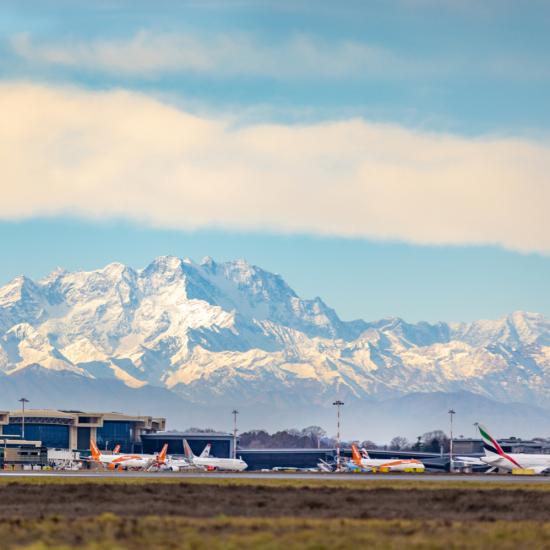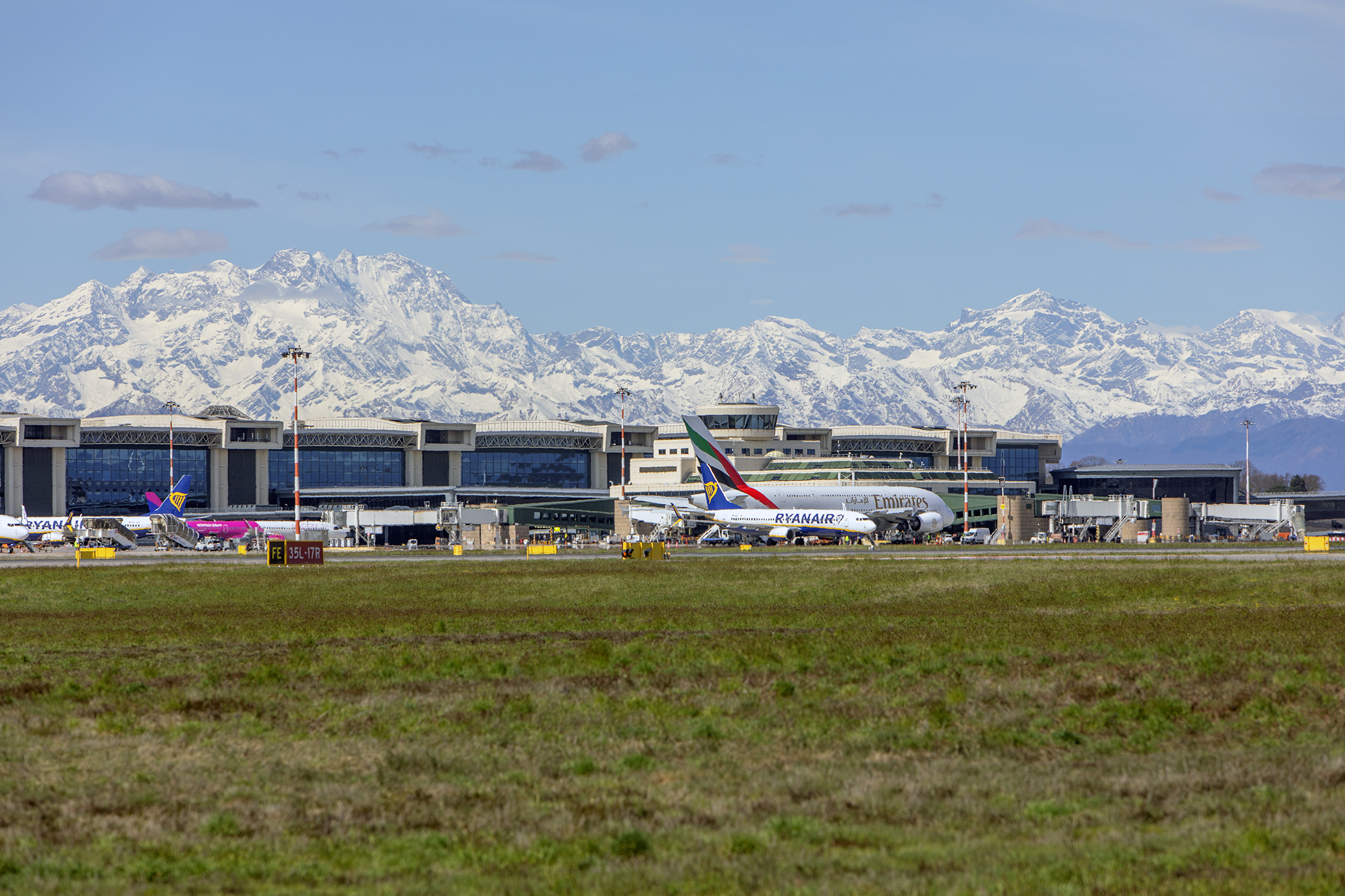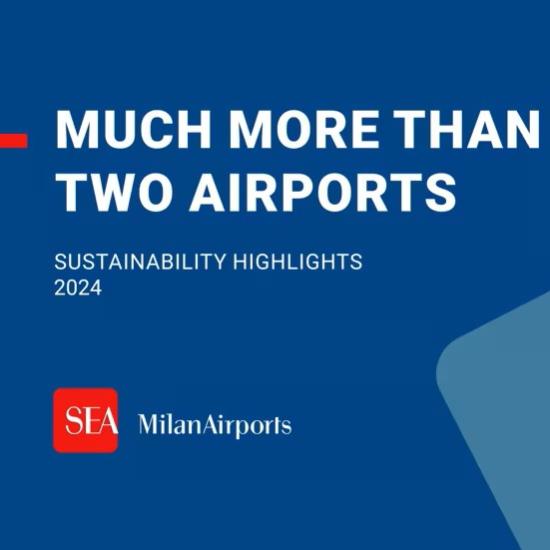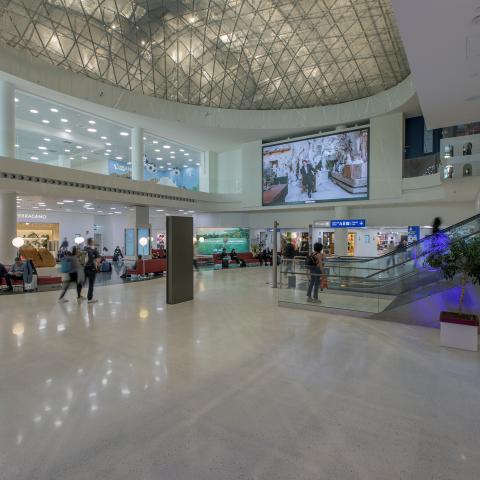SUSTAINABILITY RESULTS
Our journey toward increasingly sustainable horizons
Milano Malpensa and Milano Linate are much more than two airports.
They are engines of development, sources of opportunity, and active players in a region striving to grow toward ever more sustainable horizons.
Watch the video to discover the main sustainability results we achieved in 2024.
VISION OF SUSTAINABILITY
Territory, people, future: our horizon
For people, for the environment, for communities.
We connect our territory to the world, creating links that generate value.
We work every day to make our airports more innovative, safe, welcoming and sustainable.
Sustainable development starts from here.
We innovate to do better, in every area.
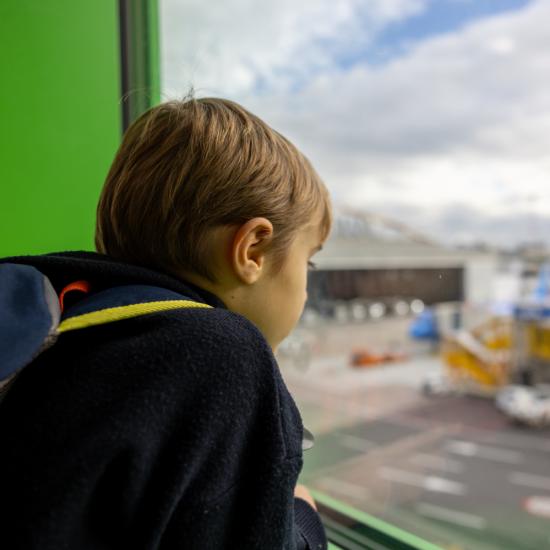
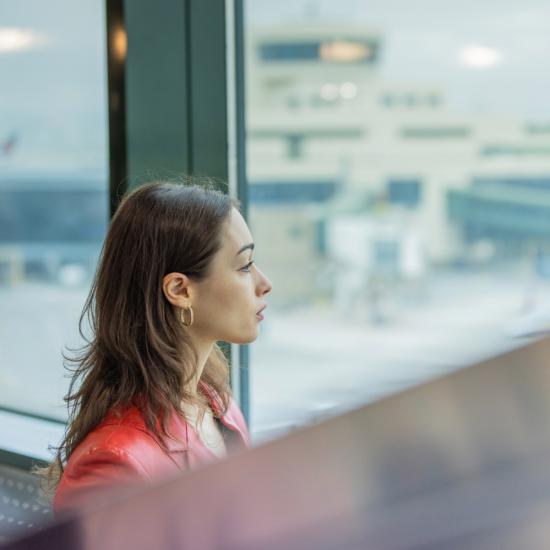
SUSTAINABLE VALUE CREATION MODEL
Shared choices, concrete impact
We are part of a community.
Our choices influence the wellbeing of the reference area and direct its development possibilities.
Dialogue with local people and institutions is continuous: it helps us define priorities, correct course, grow coherently.
The value we want to generate is solid, measurable, designed to last.
Because listening is only useful if it changes the way we act.
SEA's stakeholder relations policies contemplate the design and implementation over time of structured activities to listen to and involve stakeholders, through which opinions, perceptions, reports, suggestions and assessments are collected on the Company's reputational profile, satisfaction with the services provided, health and safety and wellbeing in the workplace, the quality of relations established with stakeholders and the impact generated on the context. Periodic surveys are carried out on samples of corporate stakeholders, divided into categories, entrusted to leading demoscopic survey institutes. These surveys are flanked - in support of relevant activities such as the drafting of airport Master Plans, a materiality analysis, and the improvement of passenger service quality - by structured moments of discussion with the most representative corporate stakeholders. SEA's main stakeholders are:
Some stakeholder categories were also involved in the impact relevance assessment process.
Discover our Value Creation Model
SEA's value creation model contemplates the various forms of non-financial capital that underpin the Company's ability to produce satisfactory economic-financial results through an increase in the level of socio-economic wellbeing in favour of the reference context.
Infrastructural capital Human capital Intellectual capital Natural capital Socio-relational capital
A description of the different capital inputs follows:
- SEA's infrastructural capital is made up of all the physical assets that enable the Company to carry out airport management and that define its operational capacity. It includes both the physical assets managed directly (terminals, runways, warehouses, car parks, etc.) and those that are not managed but are part of the "value proposition" of its airports (roads, rail access lines to the airports, etc.). Under the Convention signed with ENAC in 2001 and valid until 2043, SEA is required to implement the Airport Development Plan and provide for the infrastructural investments envisaged therein. With the coming into force of the new Programme Contract, SEA will be obliged to carry out the investments set forth in the Investment Plan attached to said contract, with a duration of five years, which identifies the new works and extraordinary maintenance works. Investments aimed at developing airport infrastructure are made on the basis of and in compliance with planning instruments, subject to the control and approval of ENAC, which regulate building activities in the areas where the two airports are located. The Master Plan is the long-term planning tool for the adaptation and development of airport infrastructure;
- Natural capital corresponds to the collection of environmental resources affected by airport processes and integrated in business processes both in the role of input and as receptors of emissions and therefore subject to possible degradation or reduction of stocks, with effects on ecosystem balances. It includes noise emissions, which in any case have a strong socio-relational component. The monitoring and management, maintenance and conservation of natural capital takes place within and through certified environmental management systems (ISO 14001, ISO 50001, Airport Carbon Accreditation);
- Human capital corresponds to the characteristics and size of the workforce of employees and collaborators. Its management and development are governed through empowerment (training, growth, health & safety, diversity) and engagement (welfare, communication, benefits) policies and actions addressed to employees and collaborators;
- Socio-relational capital corresponds to an endowment of intangible assets that play an enabling function in terms of business management and development. It concerns the quality of the relational dynamics put in place by SEA with stakeholders at all levels (corporate reputation, employee engagement, customer satisfaction, commercial policies towards customers, supply chain management);
- Intellectual capital is the intangible resource through which the Company generates skills and innovative solutions functional to the development of its business. It embraces the level of technological endowment that characterises organisational and operational processes and the ways in which internal and external competencies are activated to generate innovation.
The management output is represented by the set of characteristic activities carried out and the manner in which they are implemented. It therefore corresponds to the organisational, operational, competitive effort made during the year of reference to make the airports operate in the best interest of the territory served and in line with the latter's expectations. It includes not only the volume and quality of the operational performance delivered, but also the systemic impact generated to the benefit of the socio-economic context of reference. It defines and measures the way in which the management of the airport system has managed to act as an enabling factor and a catalyst for economic and social development, through the generation of air connectivity of adequate quality and in line with the competitive profile of the territorial system served.
The economic value generated is placed at the last stage of SEA's value creation process, signifying its derivation from and dependence on a balanced, effective and far-sighted management of capital, which makes possible a competitive offer of services and the generation of positive systemic effects capable of sustaining and consolidating over time the Company's economic-financial success and responding to the performance expectations of investors and shareholders. This interdependence describes how SEA's competitive and economic success is strongly dependent on the economic vitality of the territory and vice versa. It is clear that the presence of Linate and Malpensa in one of the most dynamic and wealthiest European areas, with a high industrial and tertiary presence, a high vocation for exports and a strongly growing tourist attraction capacity, are decisive elements for SEA's entrepreneurial success. The same applies to the role of the airports for the development of the territory, which would not be as high and resilient without them.
PEOPLE
Every direction, an opportunity
We move every day, in new directions.
We are a team of over 2,500 people, with work made up of arrivals, departures, connections.
We believe in a dynamic environment, where people can express skills, attitudes, ideas.
We share projects and goals, because growth comes from such sharing.
Everyone's energy is a resource that multiplies value.
Our people, their growth Discover the welfare projects
In each encounter, a new possibility
Creating bonds is our job. We are convinced that dialogue between differences generates value. We are committed to making the company more and more inclusive, tackling the challenges of our industry with determination.
SEA's Corporate Academy offers numerous training courses to all our employees, with the aim of building a company that respects the Company's founding values and prepares professionals to manage change. In 2024, we created specific courses for People Managers and Leaders, including the Master People Managers, the Ambrosetti Course for the development of managerial skills and the Smart Feedback course, designed to improve team management skills, enhance human capital and drive change.
We have dedicated a special focus to employees under 40, offering self-empowerment and personal development programmes, such as the 'Smart Feedback' webinar and the 'Development Centre'. These programmes are designed to train a generation of aware professionals ready to lead the future.
In 2024, we also strengthened the onboarding process for new hires, with activities such as 'A Day into Operations', a workshop which allowed participants to immerse themselves in airport operational processes, fostering an understanding of the business environment and collaboration between different areas.
In parallel, the GoodHabitz training plan, which will end in 2026 and 2027, involved our entire corporate population, offering crosscutting skills such as communication, problem solving and leadership, which are essential to deal with a continually changing work environment. In 2024, we also launched the 'train the trainer' 'Teachers SEA Academy' program.
In total, we delivered over 95,000 hours of training in 2024. This continuous commitment to the growth of our employees is a key lever for our success and for ensuring the quality of the services we offer.
In 2024, we focused on actions that foster work-life balance, promoting wellbeing, health and inclusiveness.
We consolidated healthcare initiatives, including prevention campaigns and the telemedicine service, with an increasing participation of 65% of employees.
For parenting, the 'Fly, Child!' programme has seen great participation, with the 'SEAlife' welfare bonus and reintegration courses for new mothers.
We have also supported sustainable mobility, contributing 50% to public transport passes, with a 40% increase in applications compared to 2023.
Finally, to promote work-life balance, we have confirmed remote working, flexitime and part-time working for parents, with more than 40,000 smart working days.
During 2024, we continued our efforts to create an increasingly inclusive and fair working environment, with concrete actions in three key areas: gender equality, disability and sexual and gender orientation.
We organised training courses such as 'Good Habitz', to combat mobbing and harassment, and 'Unconscious Bias', to raise awareness against stereotypes. In cooperation with Fondazione Libellula and Valore D, we promoted initiatives such as the webinar “Forse anch’io” ('Maybe Me Too') and the exhibition “Com’eri vestita” ('How You Were Dressed'), with the aim of raising awareness on issues such as violence against women.
In December 2024, we launched the “SEA con TE” ('SEA with YOU') project, aimed at fostering the inclusion of colleagues with disabilities by analysing and improving corporate culture and infrastructure for greater accessibility.
We also worked on sexual and gender orientation, partnering with Parks and collaborating with AGEDO to organise webinars and activities that helped strengthen an open and inclusive environment for the LGBTQ+ community.
The results were encouraging: the 2024 engagement survey showed that 70 per cent of employees appreciated the Diversity & Inclusion activities we carried out.
We continue to work to ensure equal opportunities and build a corporate culture that is increasingly inclusive and respectful of diversity.

ENVIRONMENT
Towards an emission-free sky
Our commitment is to create economic and social development while respecting the environment. We focus on reducing our ecological footprint by supporting the energy transition of the entire aviation industry. The goal is to achieve zero emissions by 2030.
Discover the projects to reduce CO2 emissions in Scope 1, 2 and 3 at our airports
In 2024, we made significant progress towards our goal of Zero Emissions by 2030. The decarbonisation measures we have taken aim for a reduction of 107,000 tCO2eq by 2030 compared to 2010 levels, with a reduction of 40,737 tCO2eq at 31 December 2024.
The actions focus on four main strands:
- Energy efficiency: start of energy efficiency projects for operational facilities and buildings.
- Electrification: replacing the corporate fleet with electric and hybrid vehicles and creating infrastructure to power aircraft electrically.
- Renewable sources: construction of the Photovoltaic Park at Linate and purchase of green energy to power our airports.
- New fuels: setting up HVO supply infrastructure, encouraging the use of SAF and starting up green hydrogen production for airport vehicles.
These initiatives are supported by the Integrated Business Plan, with the aim of ensuring a continuous reduction of CO2 emissions and a positive impact on environmental sustainability.
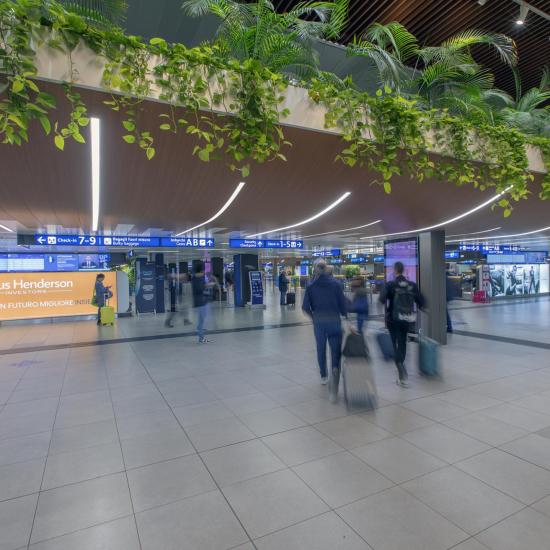
PASSENGERS
A journey towards excellence in the passenger experience
In 2024, we continued to improve the travel experience at our airports. We want them to be places to live, inspired by the modernity and dynamism of Milan. Thanks to our efforts and investments, both airports have won international recognition for the quality of their services.
Our goal is to ensure efficiency, safety and a unique experience for every passenger, thanks to a management system that continuously measures performance and promotes constant improvement. Passenger satisfaction is at the heart of everything we do.
Waiting times at check-in
In 2024, we took important steps to improve check-in waiting times at our airports. To reduce queuing, we have introduced Passenger Flow Monitoring at Malpensa Terminal 1, a technology that allows us to monitor passenger flows in real time and identify critical situations at an early stage. In this way, we can intervene promptly to improve the travel experience. In addition, we are continuing with the installation of the new Self Bag Drops at Malpensa Terminal 1, a system that simplifies the check-in process and reduces waiting times. At Linate, we are evaluating the implementation of these systems based on the results of the ongoing trial.
Assistance for PRMs (passengers with reduced mobility)
Regarding assistance to passengers with reduced mobility (PRMs), in 2024 we implemented an advanced management system called GroundStar, which allows us to optimise the allocation and planning of resources in real time. Thanks to this system, we can guarantee more timely and efficient assistance, while continuously improving the service through performance monitoring. Furthermore, we confirm our commitment to launch a new certification scheme for care services, involving disability rights associations in the field verification.
COMMUNITY AND RELEVANT AREA
A driving force for the whole area
With our Malpensa and Linate airports, we involve the surrounding area by paying attention to communities to generate opportunities and shared growth.
During 2024, Milan's airport system continued to play its role as an attractor of capital, a generator of job opportunities and an activator or catalyst of investment initiatives to the benefit of the entire Lombardy region and the entire North-West of Italy. The overall impact on Lombardy can be quantified at 45.6 EUR billion, which has generated just under 297,000 jobs.
Discover the size of the socio-economic impact generated by our airports
Protagonists of growth
Our airports play a key role in the local and national economy, stimulating trade, tourism and employment. The global connectivity of the airports favours exports, in particular in the fashion and furniture sectors, and attracts millions of tourists, with positive effects on the entire region.
In 2024, Malpensa handled €58.1 billion in cargo flows, accounting for 4.9% of Italian foreign trade, and welcomed 7.5 million tourists, generating €6.9 billion in economic impact. Linate handled 2.6 million tourists, with an economic contribution of over €1.5 billion.
The continuous influx of travellers supports sectors such as catering, transport and retail, strengthening the entire economic ecosystem. Malpensa and Linate airports are also crucial for attracting foreign investment, consolidating the competitive position of the Lombardy region and Italy in the global context.
The overall socio-economic impact of Malpensa
Malpensa kept the number of productive activities stable at 507 and supported 21,600 jobs, with a production value of €6.21bn. The indirect impact of the airport generated 13,300 jobs and €2.21bn, while the related activities generated 10,000 jobs and €2.91bn. Altogether, Malpensa generated 45,000 jobs and €11.33bn.
Overall socio-economic impact of Linate
At Linate there are 314 economic activities involving 13,600 jobs and a production value of €3bn. The indirect impact accounted for 8,400 jobs and €1bn, while the related activities generated 6,300 jobs and €1.4bn. In total, Linate generated 28,400 jobs and €5.5bn.
